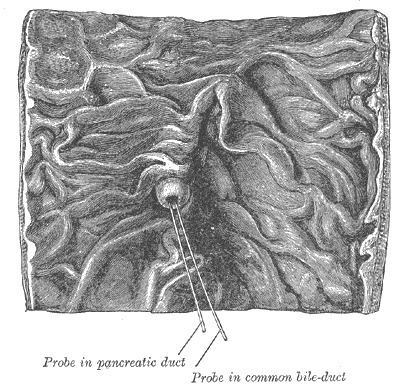Latin papilla duodeni major TA A05.6.02.015 | Dorlands/Elsevier p_03/12610350 FMA 15074 | |
 | ||
The major duodenal papilla is an opening of the pancreatic duct into the duodenum. The major duodenal papilla is, in most people, the primary mechanism for the secretion of bile and other enzymes that facilitate digestion.
Contents
Structure
The major duodenal papilla is situated in the second part of the duodenum, 7-10 cm from the pylorus, at the level of the second or third lumbar vertebrae. It is surrounded by the sphincter of Oddi, and receives a mixture of pancreatic enzymes and bile from the Ampulla of Vater, which drains both the pancreatic duct and biliary system. The junction between the foregut and midgut occurs directly below the major duodenal papilla.
The major duodenal papilla is seen from the duodenum as lying within a mucosal fold. The minor duodenal papilla is situated 2cm proximal.
Variation
The major duodenal papilla is occasionally found in the third part of the duodenum, the level of the vertebrae may be L2-3, and in about 10% of people, it may not receive bile. Additionally, in a small number of people, the primary papilla for draining the pancreas may in fact be the accessory pancreatic duct.
History
The major duodenal papilla was first illustrated by Gottfreid Bidloo in 1685, although is sometimes called the papilla of Vater, after German anatomist Abraham Vater.
